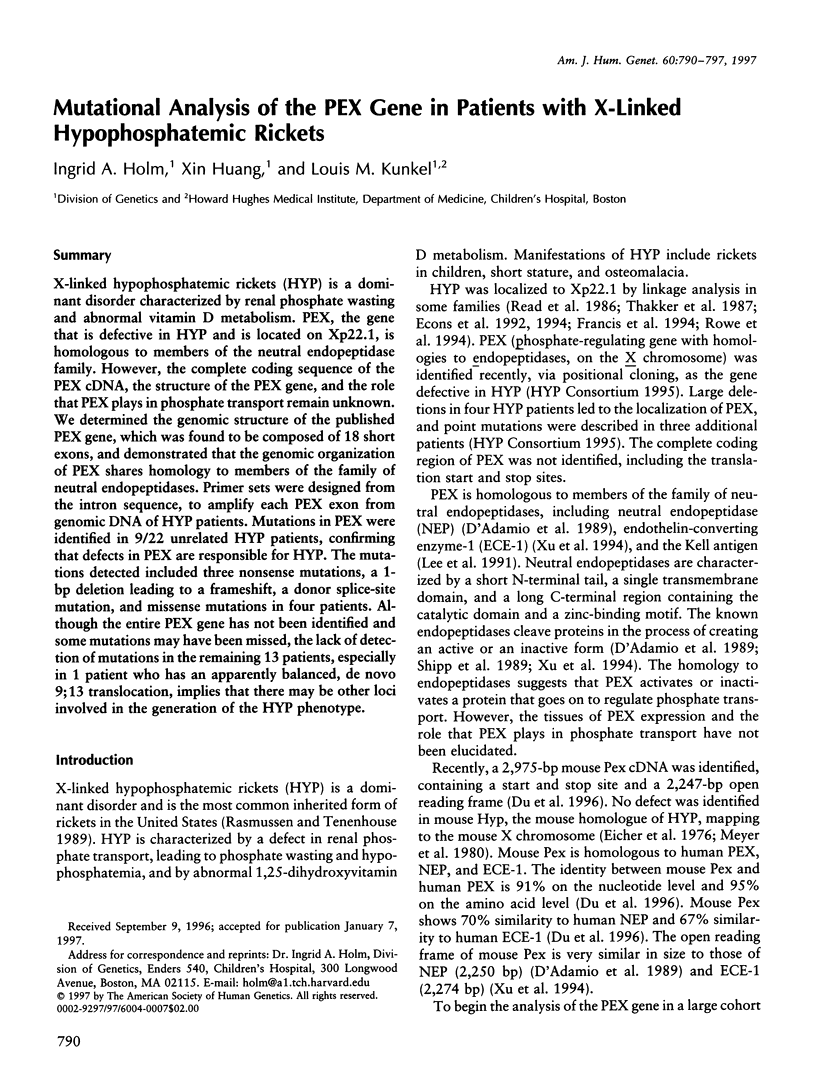Mutational analysis of the PEX gene in patients with X-linked hypophosphatemic rickets (original) (raw)
. 1997 Apr;60(4):790–797.
Abstract
X-linked hypophosphatemic rickets (HYP) is a dominant disorder characterized by renal phosphate wasting and abnormal vitamin D metabolism. PEX, the gene that is defective in HYP and is located on Xp22.1, is homologous to members of the neutral endopeptidase family. However, the complete coding sequence of the PEX cDNA, the structure of the PEX gene, and the role that PEX plays in phosphate transport remain unknown. We determined the genomic structure of the published PEX gene, which was found to be composed of 18 short exons, and demonstrated that the genomic organization of PEX shares homology to members of the family of neutral endopeptidases. Primer sets were designed from the intron sequence, to amplify each PEX exon from genomic DNA of HYP patients. Mutations in PEX were identified in 9/22 unrelated HYP patients, confirming that defects in PEX are responsible for HYP. The mutations detected included three nonsense mutations, a 1-bp deletion leading to a frameshift, a donor splice-site mutation, and missense mutations in four patients. Although the entire PEX gene has not been identified and some mutations may have been missed, the lack of detection of mutations in the remaining 13 patients, especially in 1 patient who has an apparently balanced, de novo 9;13 translocation, implies that there may be other loci involved in the generation of the HYP phenotype.

Images in this article
Selected References
These references are in PubMed. This may not be the complete list of references from this article.
- Bianchine J. W., Stambler A. A., Harrison H. E. Familial hypophosphatemic rickets showing autosomal dominant inheritance. Birth Defects Orig Artic Ser. 1971 May;7(6):287–295. [PubMed] [Google Scholar]
- D'Adamio L., Shipp M. A., Masteller E. L., Reinherz E. L. Organization of the gene encoding common acute lymphoblastic leukemia antigen (neutral endopeptidase 24.11): multiple miniexons and separate 5' untranslated regions. Proc Natl Acad Sci U S A. 1989 Sep;86(18):7103–7107. doi: 10.1073/pnas.86.18.7103. [DOI] [PMC free article] [PubMed] [Google Scholar]
- Du L., Desbarats M., Viel J., Glorieux F. H., Cawthorn C., Ecarot B. cDNA cloning of the murine Pex gene implicated in X-linked hypophosphatemia and evidence for expression in bone. Genomics. 1996 Aug 15;36(1):22–28. doi: 10.1006/geno.1996.0421. [DOI] [PubMed] [Google Scholar]
- Econs M. J., Barker D. F., Speer M. C., Pericak-Vance M. A., Fain P. R., Drezner M. K. Multilocus mapping of the X-linked hypophosphatemic rickets gene. J Clin Endocrinol Metab. 1992 Jul;75(1):201–206. doi: 10.1210/jcem.75.1.1352307. [DOI] [PubMed] [Google Scholar]
- Econs M. J., Rowe P. S., Francis F., Barker D. F., Speer M. C., Norman M., Fain P. R., Weissenbach J., Read A., Davis K. E. Fine structure mapping of the human X-linked hypophosphatemic rickets gene locus. J Clin Endocrinol Metab. 1994 Nov;79(5):1351–1354. doi: 10.1210/jcem.79.5.7962329. [DOI] [PubMed] [Google Scholar]
- Eicher E. M., Southard J. L., Scriver C. R., Glorieux F. H. Hypophosphatemia: mouse model for human familial hypophosphatemic (vitamin D-resistant) rickets. Proc Natl Acad Sci U S A. 1976 Dec;73(12):4667–4671. doi: 10.1073/pnas.73.12.4667. [DOI] [PMC free article] [PubMed] [Google Scholar]
- Francis F., Rowe P. S., Econs M. J., See C. G., Benham F., O'Riordan J. L., Drezner M. K., Hamvas R. M., Lehrach H. A YAC contig spanning the hypophosphatemic rickets disease gene (HYP) candidate region. Genomics. 1994 May 1;21(1):229–237. doi: 10.1006/geno.1994.1247. [DOI] [PubMed] [Google Scholar]
- Lee S., Zambas E. D., Marsh W. L., Redman C. M. Molecular cloning and primary structure of Kell blood group protein. Proc Natl Acad Sci U S A. 1991 Jul 15;88(14):6353–6357. doi: 10.1073/pnas.88.14.6353. [DOI] [PMC free article] [PubMed] [Google Scholar]
- Meyer R. A., Jr, Gray R. W., Meyer M. H. Abnormal vitamin D metabolism in the X-linked hypophosphatemic mouse. Endocrinology. 1980 Nov;107(5):1577–1581. doi: 10.1210/endo-107-5-1577. [DOI] [PubMed] [Google Scholar]
- Read A. P., Thakker R. V., Davies K. E., Mountford R. C., Brenton D. P., Davies M., Glorieux F., Harris R., Hendy G. N., King A. Mapping of human X-linked hypophosphataemic rickets by multilocus linkage analysis. Hum Genet. 1986 Jul;73(3):267–270. doi: 10.1007/BF00401242. [DOI] [PubMed] [Google Scholar]
- Rowe P. S., Goulding J., Read A., Lehrach H., Francis F., Hanauer A., Oudet C., Biancalana V., Kooh S. W., Davies K. E. Refining the genetic map for the region flanking the X-linked hypophosphataemic rickets locus (Xp22.1-22.2). Hum Genet. 1994 Mar;93(3):291–294. doi: 10.1007/BF00212025. [DOI] [PubMed] [Google Scholar]
- Shipp M. A., Vijayaraghavan J., Schmidt E. V., Masteller E. L., D'Adamio L., Hersh L. B., Reinherz E. L. Common acute lymphoblastic leukemia antigen (CALLA) is active neutral endopeptidase 24.11 ("enkephalinase"): direct evidence by cDNA transfection analysis. Proc Natl Acad Sci U S A. 1989 Jan;86(1):297–301. doi: 10.1073/pnas.86.1.297. [DOI] [PMC free article] [PubMed] [Google Scholar]
- Thakker R. V., Read A. P., Davies K. E., Whyte M. P., Weksberg R., Glorieux F., Davies M., Mountford R. C., Harris R., King A. Bridging markers defining the map position of X linked hypophosphataemic rickets. J Med Genet. 1987 Dec;24(12):756–760. doi: 10.1136/jmg.24.12.756. [DOI] [PMC free article] [PubMed] [Google Scholar]
- Xu D., Emoto N., Giaid A., Slaughter C., Kaw S., deWit D., Yanagisawa M. ECE-1: a membrane-bound metalloprotease that catalyzes the proteolytic activation of big endothelin-1. Cell. 1994 Aug 12;78(3):473–485. doi: 10.1016/0092-8674(94)90425-1. [DOI] [PubMed] [Google Scholar]